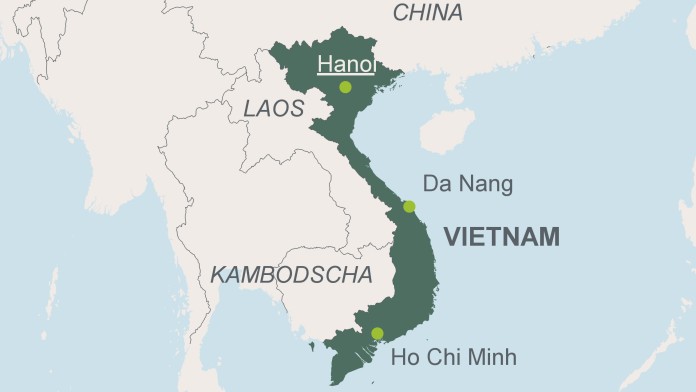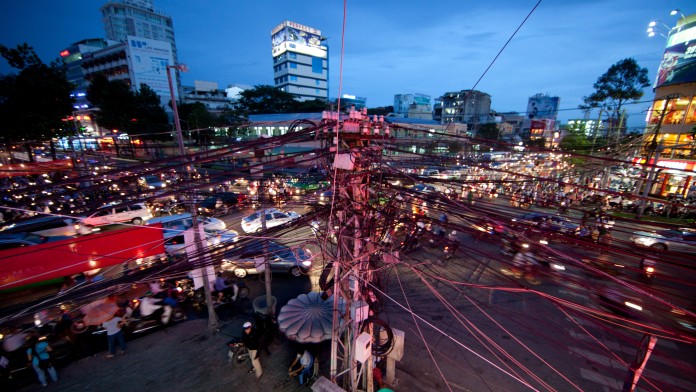
As of: 08/2022
Where the economy is growing fast, the demand for energy usually also rises considerably. A good example is Vietnam. When real GDP rose by 7% in 2018, the national electricity consumption climbed by almost 11%. In view of increasing supply bottlenecks and ever more frequent power cuts and losses, the Vietnamese government decided to make public funds available for electricity supply and to invest massively in the expansion and modernisation of the grids. Up to USD 6 billion is to flow into the energy sector by 2030. Almost half of this is earmarked for the rehabilitation and expansion of the overloaded transmission and distribution networks, which are to be densified and upgraded by "smart" solutions. The use of smart technology is part of the national energy expansion plan.

According to EVN, the state-owned energy supplier, almost 100% of all private households and 100% of all municipalities in Vietnam are supplied via the public power grid - significantly more than in comparable countries in the region. According to the World Economic Forum however, the gap between energy supply and demand is one of the main reasons why Vietnam is only 81st in the global competitive ranking, and only 88th in terms of energy supply (Global Competitiveness Report).
Over the years many weaknesses have become apparent in the current pipeline networks which were financed by private investors in the 1990s, especially in the quality of electricity supply. The result is more and more power outages and losses. Supply bottlenecks threaten to occur in the medium term, especially in southern Vietnam, where demand for electricity is growing faster than the national average due to higher economic growth. In some regions, demand here is rising by an average of 20% per year. This is also the case in the industrial areas surrounding the capital Hanoi. Numerous Asian companies from South Korea, Japan and China are to be found here, which also depend on a highly reliable electricity supply for their warehouses, logistics centres and production facilities, for example to ensure the cold chain.
The Vietnamese government intends to significantly expand its power generation capacities. The plan is to achieve an increase to 117 GW in 2030 (compared to 34 GW in 2014).
In order to meet the growing demand for electricity as well as the international climate targets to which Vietnam has committed itself in its Green Growth Strategy smart grid management is extremely important. Using flexible control technology at all voltage levels it is thereby possible to react within milliseconds to fluctuations in the electricity sup supply and to control the grids in such a way that electricity is delivered in real time exactly where it is needed. To achieve this, digital communication must be ensured at all voltage levels - high, medium and low - so that the systems can regulate themselves, react, switch on and off at any time. The transformer stations, the sensitive nodes for a functioning power supply, are of critical importance here.
A special feature of this project which will be implemented in two phases and has a volume of 350 million euros is the fact that it is divided into around 90 individual sub-projects, which will directly benefit the local economy. It is mainly small and medium-sized enterprises in Vietnam that assume the production of clamps, insulators, and ropes, draw paths to the individual power poles and erect foundations and concrete poles for the power lines. Smaller transformers for urban areas are also produced locally. This directly benefits the local economy and creates jobs.
The project should reduce energy losses in the grid by one fifth and reduce outages by an average of 15%. As a result, less coal and other fossil fuels will be used to generate electricity and around 200,000 tonnes of CO2 and other emissions will be avoided each year.
Functioning grids that can absorb and distribute large quantities of electricity are also important for Vietnam's ambitious solar and wind projects. Since the development of these renewable energies in Vietnam is still at an early stage, experience with these technologies is still limited. However, in order to achieve national climate targets Vietnam is increasingly focusing on the expansion of renewable energies. Especially in this context, smart and climate-friendly technologies are in high demand because the power grids must be able to integrate the fluctuating power input from wind power and solar energy. Electricity grids that are intelligently regulated and controlled contribute to stabilizing the grid and ensure the security of supply.
The project contributes to the achievement of these following United Nations Sustainable Development Goals:
KfW Group
KfW Development Bank
Competence Centre Energy and Climate
Share page
To share the content of this page with your network, click on one of the icons below.
Note on data protection: When you share content, your personal data is transferred to the selected network.
Data protection
Alternatively, you can also copy the short link: kfw-entwicklungsbank.de/s/enzBYwX5
Copy link Link copied